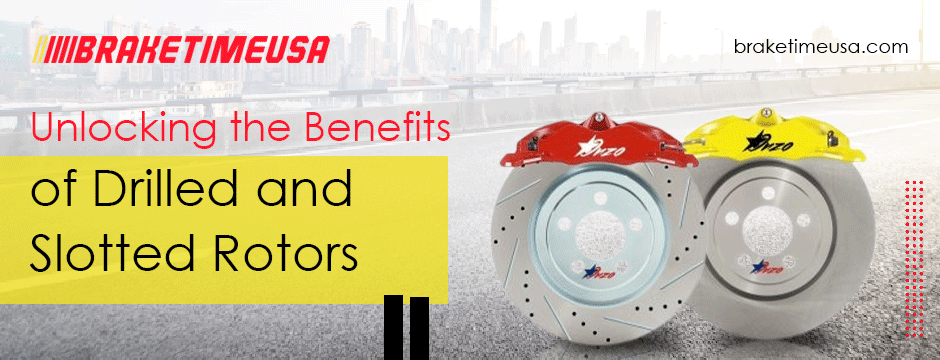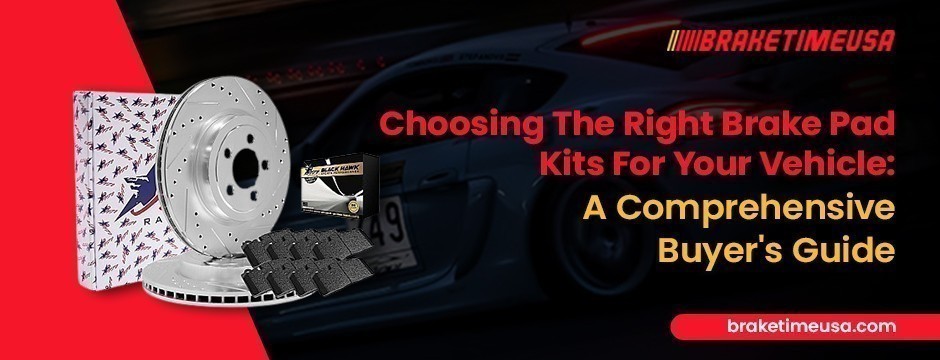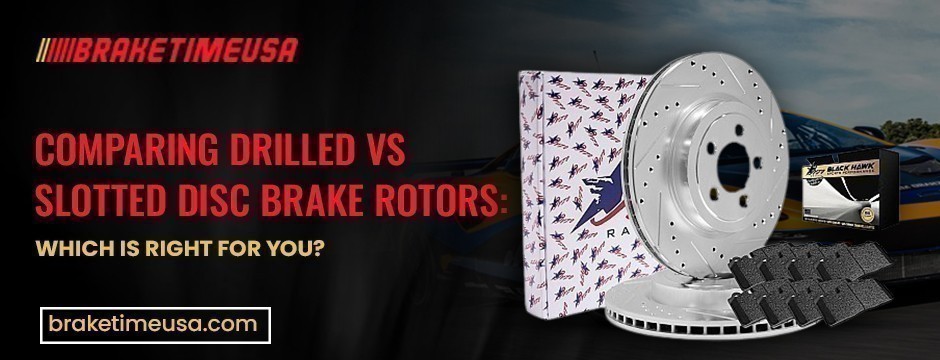Your cart is empty
Subtotal:$0.00
The brake pad kits are among the most essential parts of the braking system. When this occurs, they are your greatest allies and might mean the difference between a crash and a near miss. Because brake pads are constantly worn down as you apply them, they are not designed to last forever. As a result, knowing when to replace them, what to replace them with, and how to assess their current state becomes crucial.
To ensure that you and your loved ones are always safe on the road, we will walk you through the entire brake pad replacement process and assist you in making the best choice.
There are four main categories of brake pads on the market, which vary based on the materials and composition. Performance, cost, longevity, robustness, and construction all vary. Choosing the right one is essential because each has advantages and is appropriate for varying driving situations. Let's look at each one to understand better which is best for your car.
Since they include a significant proportion of metal (30 to 70%) combined with other components like steel wool, copper, graphite, iron, etc., these are also known as metallic brake pads. Because of their efficient braking capabilities, commercial cars will likely use semi-metallic brake pads.
Due to their high wear resistance, metallic brake pads have a lengthy lifespan. These brake pad types are perfect for heavy-duty cars that must function for an extended period and handle loads.
Metallic brake pads are less expensive than most other options but have superior heat dissipation and a longer lifespan than organic brake pads. They are heavier than most equivalents, harsher on the brake rotors, produce a lot of dust, and operate worse in colder weather. As a result, there are better choices for those who need exceptionally high performance or frequently encounter freezing temperatures.
Superior Heat Dissipation,
Durability,
and Stopping Power
Noisy,
May Damage Rotor Early,
and Less Effective in Cold Climates
Suitable for workhorses, pickup trucks, and heavy-duty vehicles
Affordable alternatives
Durability
Ceramic materials are better at dissipating heat, are more wear-resistant, which means they last longer, and emit less dust—all qualities that make them perfect for use as brake pads. Additionally, compared to most other brake pad types of comparable size, they are lighter. These features are primarily appropriate for high-performance and sports cars and come at an extremely high cost.
High stopping power,
Low rotor wear,
Quiet operation,
Less brake dust,
Long lifespan,
And exemplary performance in all weather situations
High cost
Suitable for sports and high-performance cars
The best brake pad upgrade with overall good performance
Non-asbestos organic, or NAO, brake pads are constructed of organic materials and were created to reduce the pollutants produced as materials wear off due to friction between the pads. Organic brake pads glued to resin are made with pollution control in mind and effectively address that challenge. Organic brake pads are currently constructed from rubber, glass, and occasionally Kevlar. These materials are simple to discard and do not release pollutants when they wear. The primary disadvantage is that they wear out more quickly and aren't suitable for heavy-duty or performance applications because they are composed of softer organic materials. These brake pads are intended for compact cars and smaller sedans driven in moderate conditions.
Low Rotor Wear,
Silent Function,
Gentle on Brake Discs
Quick wear,
Increased brake dust,
And shortened lifespan
Perfect for small cars
Affordable replacements and comfortable driving are made possible by the noiseless operation.
We're headed in the right direction now that you know the many kinds of brake pads on the market. The appropriate brake pad kits must be fitted for optimal stopping power and safety for you and your ride, depending on the kind of car you drive.
Finding out what is currently fitted on your vehicle is the first step in selecting the appropriate set of brake pads. This examination will save you a great deal of time if you have OEM brake pads and are replacing them for the first time. Additionally, you may easily swap out the aftermarket brake pads now fitted on your car if they have performed exceptionally well for a new pair.
We suggest the following brake pad configurations based on the kind of vehicle to ensure the optimum fit for your journey. But there are many more things to think about, which we'll cover in the next part.
Organic and semi-metallic brake pads are appropriate for their performance for hatchbacks, small sedans, and other compact cars. The decision you make between the two depends on your needs. Semi-metallic is preferable if you want a longer lifespan, whereas organic is better suited for consumers who use their appliances rarely and desire quieter operations.
For mid-sized cars, semi-metallic brake pads are the best option. These are reasonably priced and offer good performance. Ceramic brake pads, on the other hand, are a better fit if you need more performance or frequently encounter inclement weather.
Ceramic brake pads are standard on many contemporary sports sedans and coupes because they balance longevity and performance. The sole disadvantage of ceramic brake pads is their expensive cost and poor winter performance. Sintered brake pads are an excellent option for high-performance vehicles, such as track racers, because they function well in most weather conditions, can sustain high temperatures, and have exceptional wear resistance, which makes them perfect for rough and tumble driving.
More stopping power is needed for larger weight and load capability. The ideal alternative is heavy-duty metallic brake pads because they offer the most stopping force. Typically, these cars need pads that can withstand high temperatures with ease.
Choosing the proper brake pad kits for your car depends on several factors, including your driving style and type. As a result, it is wise to consider all the options and select the right product for the vehicle.
The ideal brake pad for you will differ based on the kind of car you drive. For further details, see this section.
Most brake pads function best in hot and dry weather, but not all can withstand extreme heat or cold. While they work well in warm, humid, and somewhat cold weather, metallic brake pads are inappropriate for extremely cold climates. Although ceramic brake pads offer a wider operating temperature range, you can have problems heating them to a temperature where they work properly.
Do you spend more time driving on highways or in city traffic? During city commutes, rapid and frequent stops are necessary, and low-metallic NAO brake pads can help. If you primarily drive on highways, stopping at higher speeds requires more robust brake pads and better brake performance, which can be attained with ceramic or semi-metallic brake pads.
Serious-duty metallic or sintered brake pads give heavy-duty cars enormous stopping power for towing or transporting. These pads have a lengthy service life and can sustain strong braking forces.
Ceramic and organic brake pads are a good option if noise is an issue because they produce very little noise. Organic brake pads can be purchased for significantly less than ceramic ones, but you should also consider their performance limits.
Certain types of brake pads have the potential to emit brake dust. However, most contemporary brake pads are made of safe, eco-friendly materials. Brake dust is still created by wear and friction that can accumulate on the wheels, brake discs, and other suspension parts. Ceramic brake pads least produce brake dust. Compared to ceramic brake pads, brake dust is produced by organic and metallic brake pads much more often.
Performance and dependability are ultimately determined by each manufacturer's design and manufacturing procedures. Choosing the right technology might be challenging because so many manufacturers are available. For the most significant technological prowess, the secret is to stay with reputable brands and tried-and-true products.
Although more expensive, high-performance brake pads provide the best braking, longevity, quietness, and durability. Ceramic brake pads are the priciest kind. The cost of sintered brake pads might also be high. Organic pads are an affordable replacement for most automobiles, being the least expensive option. Brake pads that are semi-metallic fall in between ceramic and organic brake pads.
As was previously mentioned, the performance of the brake pads is directly impacted by their composition. Although metallic and semi-metallic brake pads provide superior braking, longevity, and durability, they can also produce more brake dust and be loud. Organic brake pads are gentler on rotors and more environmentally friendly, but they last shorter and offer less braking force. Finally, ceramic pads are more expensive but provide a potent, silent, dependable combination.
It's time to examine your automobile to see if you need to replace your brake pad kits now that you know the different kinds available and the variables that affect which type to choose.
As we already know, a vehicle's kind, terrain, traffic, climate, and individual driver's skill level can all affect how long brake pads last. However, a cursory standard indicates that a regular pair of brake pads could easily survive more than 35,000 to 40,000 miles before needing to be replaced. Therefore, the first thing to do is find out how many miles your automobile has already driven and whether the car's braking performance has changed. This way, you can decide if your brake pads and associated parts must be checked further.
Every time we apply the brakes, the pads endure continuous stress and friction, which causes them to deteriorate. By exerting the necessary frictional force on the rotors to stop the wheels from rotating, they are made to withstand all of the abuse and bring the car to a halt. As a result, distinct symptoms will become apparent when it's time to change your car's brake pads. It is essential always to take these symptoms seriously because you do not want to be driving a vehicle with a potentially failing brake system soon.
This is the first sign of worn-out brake pads every time you press the brakes. This will produce a sound similar to two metal bodies rubbing against one another. For this reason, specific brake pads have unique metallic shim indicators incorporated in them. This lets the motorist know it's time to replace those worn-out brake pads immediately.
Note: It is important to remember that the sound may occasionally be caused by dirt and debris becoming lodged between the rotor and the pads. These noises typically go away once cleaned or as the dust settles.
Since the brake pads physically deteriorate over time, their thickness steadily decreases. It's usually time to replace them when the thickness reaches roughly 1/4 of an inch or 3 mm.
This deep grind or growl will come from the area if the brake calipers and disc brakes are in contact with each other due to worn-out brake pads. This must be fixed because it can cause the brake system to fail.
When you slow down to a specific RPM or speed, the brake pedal or steering wheel may vibrate sometimes. This is a sign that the brake pad or rotor is worn out. So, it is recommended to inspect right away.
Some cars have a low-pad warning system with a unique indication light on the dashboard to indicate when to change the brake pads. The motorist will save much time by using this essential and beneficial knowledge.
Brake pad kits are critical components of your vehicle's braking system, serving as your first line of defense against accidents. Knowing when to replace them and selecting the right type for your vehicle is essential for maintaining safety on the road. Whether you opt for metallic, ceramic, or organic brake pads depends on various factors such as vehicle type, driving conditions, and personal preference. Understanding the lifespan of brake pads and recognizing signs of wear and tear can help you stay proactive in ensuring your vehicle's optimal performance and safety.
Remember, squealing or screeching sounds, decreased pad thickness, growling or grinding noises, brake pedal vibrations, and indicator lights are all indicators that your brake pads may need replacement. Ignoring these signs can lead to compromised braking performance and, ultimately, safety risks. Therefore, it's crucial to address any issues promptly and replace worn-out brake pads to maintain your vehicle's braking efficiency and keep yourself and others safe on the road.
By taking the time to understand the various types of brake pads available, considering your vehicle's specific needs, and staying vigilant for signs of wear, you can make informed decisions regarding brake pad replacement and ensure the continued safety and reliability of your vehicle's braking system. So, whether you're driving a compact car, mid-size sedan, sports car, or heavy-duty vehicle, choosing the right brake pads and staying proactive about maintenance will help keep you safe and secure on your journey.
If you are looking for more insights on the best brake pads online, do follow us at ! Mar 27, 2024Unlocking the Benefits of Drilled and Slotted Rotors
Mar 27, 2024Unlocking the Benefits of Drilled and Slotted Rotors Mar 22, 2024Choosing The Right Brake Pad Kits For Your Vehicle: A Comprehensive Buyer's Guide
Mar 22, 2024Choosing The Right Brake Pad Kits For Your Vehicle: A Comprehensive Buyer's Guide Mar 18, 2024Exploring Different Types of Rear Brake Rotors
Mar 18, 2024Exploring Different Types of Rear Brake Rotors Mar 6, 2024Comparing Drilled vs. Slotted Disc Brake Rotors: Which Is Right for You?
Mar 6, 2024Comparing Drilled vs. Slotted Disc Brake Rotors: Which Is Right for You?
 Feb 5, 2024Comprehensive Guide on How To Check Brake Pads and Rotors for Optimal Maintenance
Feb 5, 2024Comprehensive Guide on How To Check Brake Pads and Rotors for Optimal Maintenance© 2023 - 2024 Braketimeusa. All rights reserved.
